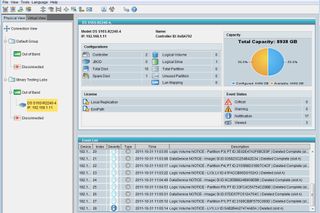However, it's worth taking a moment to get to grips with how storage is handled by the appliance. Logical drives are collections of physical hard disks grouped together in a RAID array. Once you've created a logical drive you can then create logical volumes. A logical volume can be confined to a single logical drive or it can be spread over multiple logical drives for even greater fault tolerance.

The SANWatch Commander provides a complete overview of all Infortrend storage appliances present on the network.
A logical volume comprises the total capacity of all included logical drives. Volumes can be divided into partitions. These are the actual storage devices that will be presented to your servers and are mapped to either controller and assigned a unique LUN.
Plenty of backup options are available. Snapshots provides point-in-time copies of partitions which can be used for rollback and recovery purposes. Source partitions can also be copied or mirrored to target partitions on other volumes. Once a mirror has completed, the pair can be split and the target mapped to a new LUN.
This is useful for offloading backup tasks as the target can be removable media attached to another server, reducing any potential performance lag on the source. Once the backup has completed, the source and targets are resynchronised and then split again ready for the next backup.
Optional thin provisioning allows you to create partitions that only use a small amount of space, but appear much larger to the host servers. As capacity is used, the appliance dynamically allocates blocks to the partition and when all the space is used up you can expand a partition into any free space on the logical volume.
Dave is an IT consultant and freelance journalist specialising in hands-on reviews of computer networking products covering all market sectors from small businesses to enterprises. Founder of Binary Testing Ltd – the UK’s premier independent network testing laboratory - Dave has over 45 years of experience in the IT industry.
Dave has produced many thousands of in-depth business networking product reviews from his lab which have been reproduced globally. Writing for ITPro and its sister title, PC Pro, he covers all areas of business IT infrastructure, including servers, storage, network security, data protection, cloud, infrastructure and services.

